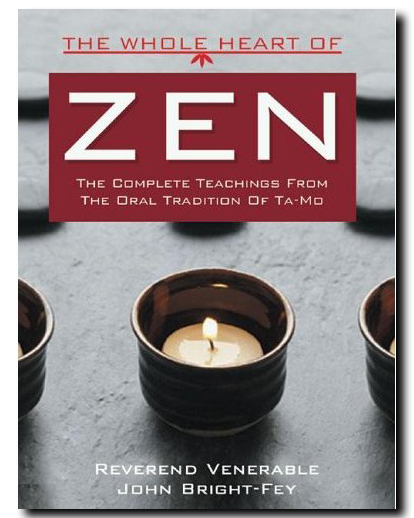|
The Whole Heart of Zen: The Complete Teachings from the Oral Tradition of Ta-Mo
By Sifu John Bright-Fey, published by Crane Hill Publishers, June 2006
Reviewed by Ned Mudd

The vast majority of practitioners of modern Zen Buddhism share a tradition that revolves, in great part, around zazen, or sitting meditation. In addition, Zen traces its roots through the First Patriarch of Chinese Ch’an, Ta-Mo (Bodhidharma), directly back to Shakyamuni Buddha. So far, so good.
By way of the ancient written sources, such as “The Blue Cliff Record,” Zen is informed of its lineage in more or less certain terms. That the historical record is at times inclined towards hagiography isn’t considered a stumbling block to the overall coherence of Zen’s long, winding legacy of “seeing into one’s true nature” and the experience of enlightenment.
 However, with the publication of Sifu John Bright-Fey’s “The Whole Heart of Zen,” a fascinating reappraisal of Ch’an is introduced to the Buddhist community; an approach that some may find challenging due to the book’s origins: An oral tradition, truly “outside the scriptures,” to coin one of Ta-Mo’s most cited phrases. However, with the publication of Sifu John Bright-Fey’s “The Whole Heart of Zen,” a fascinating reappraisal of Ch’an is introduced to the Buddhist community; an approach that some may find challenging due to the book’s origins: An oral tradition, truly “outside the scriptures,” to coin one of Ta-Mo’s most cited phrases.
According to Sifu Bright-Fey, 12th generation lineage holder of the Blue Dragon Order of Esoteric Zen Buddhism, a distinct line of knowledge descended directly from Shaolin Temple not only exists, but is alive and well. This shouldn’t come as a big surprise to most practitioners, as much of Ch’an/Zen has evolved via mind to mind transmission, as opposed to being codified in manuscript form.
Where Sifu Bright-Fey rattles the proverbial cage is in his proffer that, despite Ta-Mo’s alleged nine years of wall gazing, zazen was simply one aspect of the First Patriarch’s technology of enlightenment. The other legs included his Eighteen Hands of the Lohan, Muscle/Tendon Changing, Marrow Washing, and other playful transformative movements. The latter would eventually be expanded by subsequent masters into what we call kung fu, a highly meditative series of moves designed to allow the practitioner a glimpse of “the self.”
As most of today’s Zen adherents recognize, Ch’an veered into uncharted territory upon the Sixth Patriarch’s (Hui Neng) relocation to Southern China, coupled with his teachings, extant in “The Platform Sutra.” Sifu Bright-Fey is of the mind that, concomitant with the rise of Hui Neng’s “sudden enlightenment” school, Ch’an jettisoned transformative movement, adopting sitting meditation as the preferred technology on the road to Satori; and, that this sideways step was both a needless and erroneous development.
According to oral tradition, Ta-Mo’s arrival into China’s rich culture introduced him to various forms of qigong, Taoist philosophy, and numerous healing arts. As a member of India’s ksatreya (warrior) class, Ta-Mo was already adept at various fighting skills (natas) that doubled as spiritual cultivation technologies. Upon his discovery that the monks at Shaolin were overly focused on quietude, to the point of being physically out of shape, Ta-Mo melded indigenous qigong with his knowledge of a nata known as “ashtada-savit-jaya” in order to reshape the energetics of his student’s body/minds. Thus was born Ta-Mo’s Eighteen Hands.
Sifu Bright-Fey says, “on the occasion of the very first introduction of the Eighteen Hands to the members of the Shaolin Temple, more than half of the monks in attendance achieved sudden awakening.” The good news is that “The Whole Heart of Zen” expounds not only the direct pointing of Ta-Mo’s teachings (via a series of cantos), but the Eighteen Hands (qigong), as well. Of course, reading about transformative movement is one thing, tasting it is another.
As Ta-Mo would likely bark: “No reliance on words or letters!”
|
Search thezensite
Updates to thezensite
Zen Book Reviews
Miscellaneous & Reading Lists
Book Sources
Zen Links
Journals and Acedemic Sites of Interest
Miscellaneous
Non-Zen Topics
Essays of Interest
Interesting Sites
Miscellaneous
humour
art
If you wish, you may make a small donation to help this site defray overhead costs.
Thank you.
|
